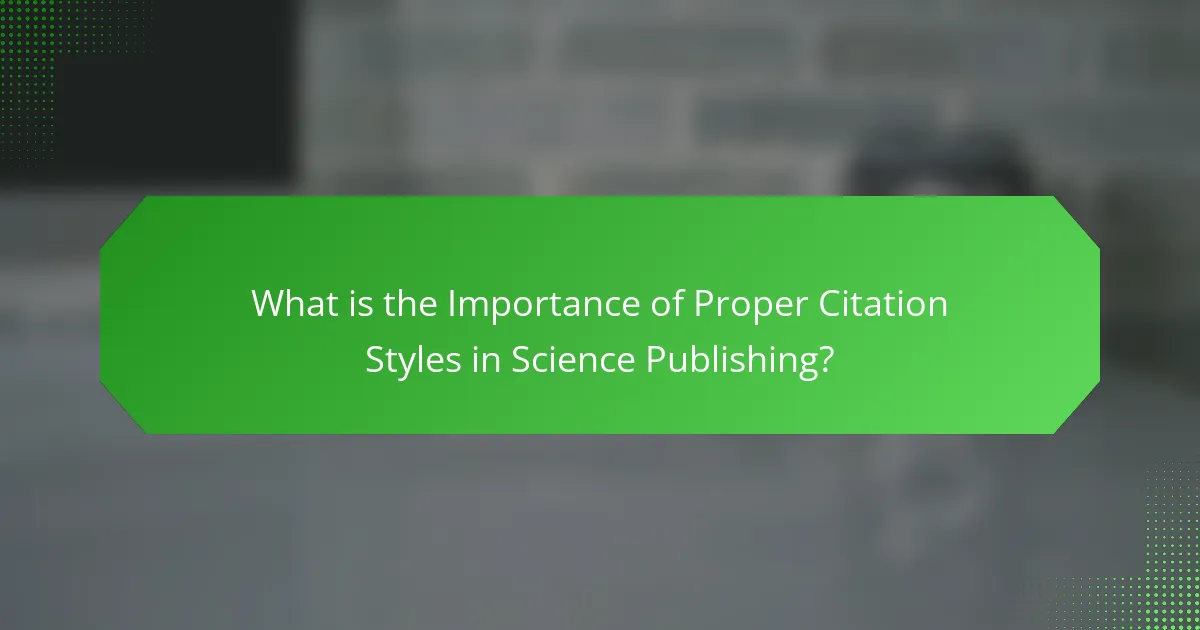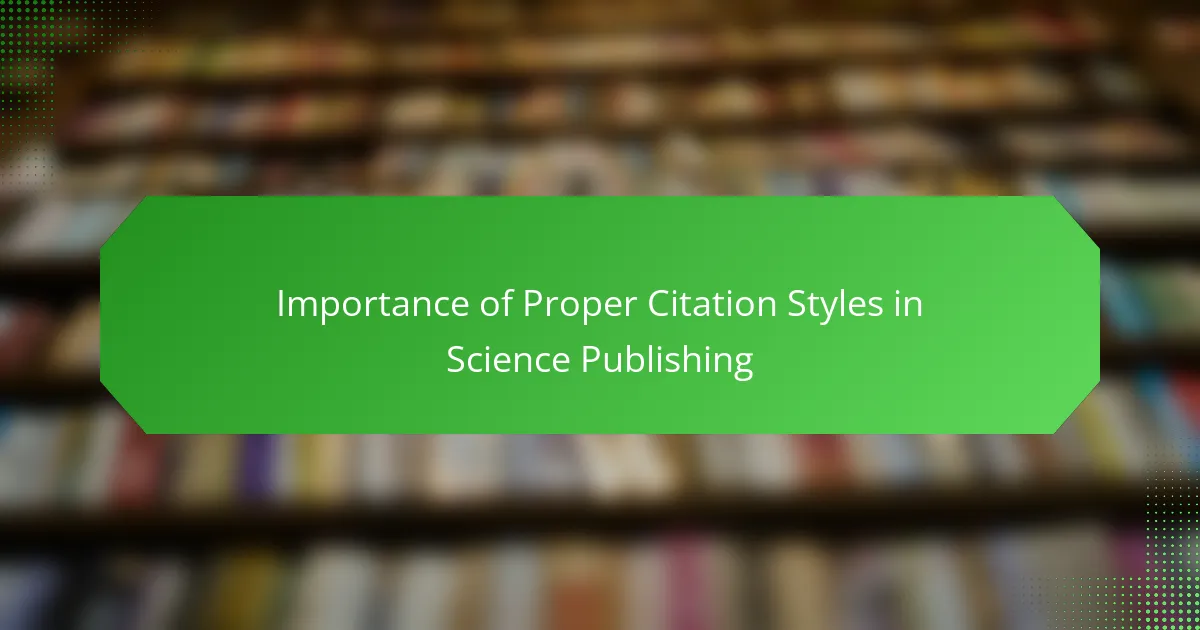Proper citation styles are crucial in science publishing for maintaining academic integrity and fostering trust within the research community. They provide a standardized method for acknowledging sources, preventing plagiarism, and enhancing the credibility of research findings. Accurate citations allow readers to locate referenced works easily and contribute to the reproducibility of research. Various disciplines utilize specific citation styles, such as APA and MLA, reflecting their conventions. Best practices for effective citation include consistent application, attention to detail, and the use of citation management tools, all of which reinforce the importance of proper attribution in scholarly work.

What is the Importance of Proper Citation Styles in Science Publishing?
Proper citation styles in science publishing are essential for maintaining academic integrity. They provide a standardized method for acknowledging sources. This practice helps prevent plagiarism by giving credit to original authors. Accurate citations also enable readers to locate the referenced works easily. Furthermore, proper citation enhances the credibility of the research. It demonstrates thoroughness and respect for the scholarly community. Research shows that well-cited articles are more likely to be trusted and referenced by others. A study published in “PLOS ONE” by Wang et al. (2019) indicates that proper citations significantly influence the impact of scientific publications.
Why are citation styles crucial for scientific communication?
Citation styles are crucial for scientific communication because they provide a standardized method for referencing sources. This standardization enhances clarity and consistency in scholarly writing. Proper citation allows readers to trace the origins of ideas and data, ensuring transparency in research. It also helps to avoid plagiarism by giving credit to original authors. Various fields use specific citation styles, such as APA or MLA, to meet disciplinary norms. Studies show that consistent citation practices improve the credibility of research. Additionally, citation styles facilitate peer review and collaboration among scientists. They are essential for maintaining the integrity of the scientific record.
What role do citation styles play in academic integrity?
Citation styles ensure academic integrity by providing a standardized method for acknowledging sources. They help prevent plagiarism by clearly attributing ideas and research to their original authors. This practice fosters trust in academic work. Proper citation allows readers to verify sources, enhancing the credibility of the research. Different fields have specific citation styles, such as APA, MLA, and Chicago, which guide how citations should be formatted. Adhering to these styles demonstrates respect for intellectual property. Studies show that consistent citation practices contribute to the overall quality of academic writing. Thus, citation styles are essential for maintaining ethical standards in scholarly communication.
How do citation styles enhance the credibility of research?
Citation styles enhance the credibility of research by providing a standardized format for referencing sources. This standardization allows readers to easily verify the information presented. When citations are consistent, they demonstrate the author’s attention to detail and adherence to academic norms. Accurate citations also help to prevent plagiarism by clearly attributing ideas to their original authors. Furthermore, citation styles facilitate the organization of research, making it easier for others to follow the author’s thought process. Studies show that well-cited papers are often viewed as more trustworthy and are cited more frequently by other researchers. This increased visibility can lead to greater recognition and impact within the academic community.
What are the key elements of citation styles?
Key elements of citation styles include author names, publication year, title, and source details. Author names identify the creator of the work. The publication year provides the context of when the work was released. The title indicates the specific work being cited. Source details include the publisher, journal name, volume, and page numbers. These elements ensure proper attribution and allow readers to locate the original work. Consistency in formatting these elements is crucial for clarity and credibility in scientific publishing.
What components are common across different citation styles?
Common components across different citation styles include the author’s name, publication year, title of the work, and source information. These elements are essential for identifying and locating the referenced material. The author’s name typically appears first, followed by the publication year in parentheses. The title of the work is usually italicized or in quotation marks, depending on the citation style. Source information often includes the publisher’s name and location for books or the journal name and volume for articles. Consistency in these components ensures clarity and credibility in academic writing.
How do citation styles vary between disciplines?
Citation styles vary significantly between academic disciplines. Humanities often use MLA or Chicago style for their emphasis on authorship and publication details. Social sciences typically prefer APA style, focusing on date of publication to highlight recent research. Natural sciences generally adopt CSE or IEEE styles, prioritizing brevity and clarity in referencing. Each style serves the specific needs of its discipline, influencing how sources are credited. For instance, APA style includes the publication year in citations to reflect the importance of timely research. In contrast, MLA emphasizes the author’s name and title, reflecting a focus on textual analysis. These variations ensure that citations align with disciplinary conventions and research priorities.

How do citation styles impact the research community?
Citation styles significantly impact the research community by ensuring clarity and consistency in scholarly communication. They provide a standardized method for researchers to attribute sources, fostering trust and credibility. Consistent citation styles help prevent plagiarism by clearly indicating the origin of ideas and data. This transparency enhances the reproducibility of research findings, which is crucial for scientific progress. Various disciplines adopt specific citation styles, which reflect their unique conventions and priorities. For example, APA is prevalent in social sciences, while MLA is common in humanities. Adhering to citation styles facilitates peer review by allowing reviewers to verify sources efficiently. Overall, citation styles contribute to the integrity and quality of academic work, reinforcing the value of proper attribution in science publishing.
What are the consequences of improper citation?
Improper citation can lead to serious academic consequences. It may result in accusations of plagiarism, which can damage a scholar’s reputation. Additionally, it can lead to the rejection of manuscripts by journals. Lack of proper citations undermines the credibility of research findings. Furthermore, it can prevent readers from locating original sources. This hinders the advancement of knowledge in the field. Inaccurate citations can also mislead readers regarding the context of the research. Overall, improper citation diminishes the integrity of academic work.
How can improper citation affect a researcher’s reputation?
Improper citation can severely damage a researcher’s reputation. It can lead to accusations of plagiarism, which undermines credibility. Researchers rely on accurate citations to give credit to original ideas. Misattributing sources can suggest a lack of integrity or diligence. This can result in loss of trust from peers and institutions. A tarnished reputation may hinder future collaboration and funding opportunities. Studies show that researchers with a history of citation errors face scrutiny in their work. Maintaining proper citation practices is essential for a positive professional image.
What legal implications can arise from incorrect citations?
Incorrect citations can lead to significant legal implications, including accusations of plagiarism and copyright infringement. Plagiarism can result in loss of credibility and professional reputation. It may also lead to disciplinary actions from academic institutions or professional organizations. Copyright infringement occurs when the original work is not properly attributed, violating the rights of the original author. This can result in legal action and financial penalties. Courts have upheld the importance of proper citation in several cases, emphasizing that failing to provide accurate citations can undermine intellectual property rights.
How do citation styles facilitate collaboration among researchers?
Citation styles facilitate collaboration among researchers by providing a standardized method for referencing sources. This standardization ensures clarity in communication among scientists. Researchers can easily locate and verify cited works. Consistent citation styles reduce misunderstandings related to sources. They also enhance the credibility of research by properly attributing ideas. Various fields have established specific citation styles, such as APA and MLA. These styles align expectations across disciplines, fostering interdisciplinary collaboration. Proper citation practices ultimately strengthen the integrity of scientific discourse.
In what ways do standardized citations improve information sharing?
Standardized citations improve information sharing by providing a consistent format for referencing sources. This consistency enhances clarity and reduces confusion among readers. Standardized citations allow for easier location of original materials. They enable researchers to verify information quickly and accurately. Additionally, they facilitate the comparison of different works by maintaining uniformity in presentation. This uniformity supports effective communication across disciplines. Research indicates that proper citation practices increase the credibility of scholarly work. According to a study published in the Journal of Scholarly Publishing, standardized citations significantly impact the accessibility of research findings.
How do citation styles support interdisciplinary research?
Citation styles support interdisciplinary research by providing a standardized format for referencing sources. This standardization facilitates clear communication among researchers from different fields. It allows for the consistent presentation of ideas, making it easier to understand diverse perspectives. Additionally, citation styles help ensure the credibility of sources, which is crucial when integrating knowledge from various disciplines. By adhering to specific citation guidelines, researchers can avoid misunderstandings that arise from varying conventions. This uniformity fosters collaboration and enhances the overall quality of research outputs. Overall, citation styles are essential tools for bridging gaps between disciplines.

What are the best practices for using citation styles effectively?
Best practices for using citation styles effectively include consistent application throughout your work. Choose a citation style that aligns with your discipline, such as APA, MLA, or Chicago. Familiarize yourself with the specific rules of the selected style. Ensure all sources are accurately cited in-text and in the reference list. Pay attention to details like punctuation, capitalization, and formatting. Utilize citation management tools to organize references efficiently. Review your citations for completeness and accuracy before submission. These practices enhance the credibility of your work and ensure proper attribution to original authors.
How can researchers choose the appropriate citation style?
Researchers can choose the appropriate citation style by considering their field of study. Different disciplines prefer specific citation formats. For instance, APA is common in psychology and education. MLA is frequently used in humanities. Chicago style is often favored in history and some social sciences.
Additionally, researchers should consult the guidelines of the journal or publisher they are submitting to. Many journals specify a citation style in their submission guidelines. This ensures consistency and meets the expectations of the academic community.
Finally, researchers can use citation management tools. These tools can help format references correctly. They also provide options for various citation styles.
What factors should influence the selection of a citation style?
The selection of a citation style should be influenced by the specific requirements of the publication or discipline. Different fields have established preferred styles that enhance clarity and consistency. For example, APA is common in psychology, while MLA is favored in humanities. The audience of the work also plays a significant role; understanding their expectations can guide the choice. Additionally, the type of source material can dictate the most appropriate style. Some styles are better suited for digital sources, while others excel with print materials. Institutional guidelines may further dictate citation style preferences. Lastly, the complexity of the work’s subject matter can influence the selection, as some styles provide more detailed referencing for intricate topics.
How can researchers ensure consistency in citation usage?
Researchers can ensure consistency in citation usage by adhering to a specific citation style guide. Popular guides include APA, MLA, and Chicago. Each guide provides detailed rules for formatting citations. Following these rules helps maintain uniformity across all references. Additionally, researchers should use citation management software. Tools like EndNote and Zotero can automate citation formatting. Regularly reviewing citations for accuracy is also essential. This practice minimizes errors and discrepancies. Lastly, collaborating with co-authors on citation practices fosters consistency in multi-author works.
What tools and resources are available for managing citations?
Citation management tools include software and online resources designed to organize and format references. Popular tools are Zotero, Mendeley, and EndNote. Zotero is a free tool that helps collect, manage, and cite research sources. Mendeley offers similar features with cloud storage and collaboration options. EndNote is a comprehensive reference management software often used in academic settings. Each tool supports various citation styles, making it easier to adhere to specific formatting guidelines. These tools enhance the efficiency of managing bibliographies and streamline the writing process in scientific publishing.
Which citation management software is most recommended?
Zotero is the most recommended citation management software. It is widely praised for its user-friendly interface and robust features. Zotero allows users to easily collect, organize, and cite research materials. It supports various citation styles, making it versatile for different academic fields. According to a survey by the Journal of Academic Librarianship, over 60% of researchers prefer Zotero for its efficiency. Additionally, Zotero offers cloud storage, enabling access to references from multiple devices. This software is open-source, ensuring continuous updates and community support.
How can online resources assist in proper citation?
Online resources assist in proper citation by providing tools and guidelines for accurate referencing. Many online citation generators simplify the process of creating citations in various styles. These tools often allow users to input source information and automatically format citations correctly. Additionally, online databases and libraries offer comprehensive citation guides for different formats like APA, MLA, and Chicago. These guides include examples and specific rules for citation. Educational websites also provide tutorials and tips for avoiding common citation mistakes. Many universities offer online writing centers that help students with citation practices. These resources enhance understanding of the importance of proper citation in academic integrity.
What common mistakes should researchers avoid in citation?
Common mistakes researchers should avoid in citation include incorrect formatting of references. Adhering to specific style guidelines is crucial. Many researchers fail to follow the required citation style, leading to inconsistencies. Missing essential information, such as page numbers or publication dates, is another frequent error. Researchers often neglect to include all authors in citations, which can misrepresent the original work. Additionally, using outdated sources or not updating citations can diminish credibility. Plagiarism due to improper citation is a serious mistake that can result in severe consequences. Lastly, not double-checking citations for accuracy can lead to significant misunderstandings in the research.
How can researchers identify and correct citation errors?
Researchers can identify and correct citation errors by systematically reviewing their references. They should cross-check their citations against the original sources. This ensures accuracy in authorship, publication dates, and page numbers. Utilizing citation management tools can help streamline this process. These tools often highlight inconsistencies and suggest corrections. Additionally, researchers can consult style guides relevant to their field. These guides provide detailed rules for proper citation formats. Peer review can also serve as a valuable check for citation errors. Feedback from colleagues can help catch mistakes that may have been overlooked.
What strategies can help prevent accidental plagiarism in citations?
To prevent accidental plagiarism in citations, maintain meticulous records of all sources used. This includes noting down bibliographic details as you research. Use citation management tools to organize references systematically. Familiarize yourself with the specific citation style required for your work. This knowledge helps ensure proper formatting and attribution. Additionally, paraphrase information thoughtfully and provide citations for all paraphrased content. Regularly review your work to verify that all sources are credited appropriately. Engaging in workshops on academic integrity can further enhance understanding and awareness of plagiarism risks.
The main entity of this article is the importance of proper citation styles in science publishing. Proper citation styles are essential for maintaining academic integrity, preventing plagiarism, and enhancing the credibility of research. The article discusses the role of citation styles in scientific communication, their impact on academic integrity, and the key elements common across various styles. It also addresses the consequences of improper citation, best practices for effective citation usage, and the tools available for managing citations. Overall, the article emphasizes the significance of standardized citation practices in fostering trust and clarity within the research community.


